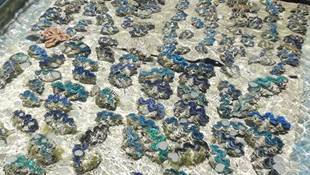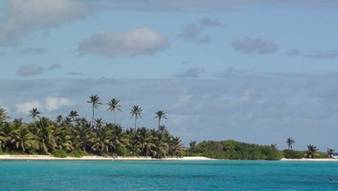More Cocos

Friday 18th October 2013 Direction Island, Cocos keeling Indian Ocean, 12.05.488S 98.52.960E Today's Blog by Peter (Time zone BST +.6.50; UTC +7.5) A different Blog editor today. The Cocos (Keeling) Islands consist of two separate coral atolls, 24 km apart, that have developed on top of ancient volcanic seamounts, rising from the a depth of 5,000 metres in the north-east Indian Ocean. The northern atoll is a single uninhabited island, now a National Park, while the main atoll to the south is a chain of islands encircling an oval shallow lagoon about 7 miles by 6. In 1836 Charles Darwin, aboard HMS Beagle, visited the islands on his round the world voyage. They were the only atolls he visited and from which he formed his theory of atoll development. The first stage is a fringing coral reef growing round the shoreline of an extinct oceanic volcano. Next as the volcano continues to subside slowly the coral continues to grow forming a barrie reef. Finally a chain of reefs enclosing a lagoon is formed over the totally submerged seamount and an atoll is born. The islands get there name from the abundant coconuts and Captain William Keeling who is believed to have sighted them in 1609 during his return from Java though there is no record of his sighting. They do however appear on charts from 16 years after then. Known about for over 200 years it was not until early in the 19th century that they were settled an interest taken because of their location on the trade route from Europe to the Far East. The first group of around hundred settlers brought to the islands in 1826 were predominately Malay with a number of people of Chinese, Papuan and Indian descent. The society that exists today has been held together for eight generations by its very isolation, shared economic endeavour, strong family loyalty, a deepening commitment to Islam and their unique version of the old Malay language of the East Indies. From 1831 until 1978 the islands were ruled, virtually as a private colony, by the Clunies-Ross family. The islands, an Australian territory with a population of 700 , no longer have any industry and are entirely supported by the mother country. Twenty visiting Oyster yachts adds a considerable load to the infrastructure. Wednesday’s tour of West Island (via a 1.5 mile dinghy ride and 5 mile ferry) produced the following photos …
Clam farm Beach Town centre with air terminal, police station & shop Yesterday we stayed closer to Home and visited Oceana House, the ancestral home of the Clunie-Ross family rulers. It is semi-occupied today with the owner only spending a few months each year in residence. This was followed by a Coco-Malay “feast” – chicken curries don’t photo well, sorry, though the appetisers were very tasty.
Outside and peeking through the window Finally I leave you with a couple pictures taken from our bows at Direction Island
|






